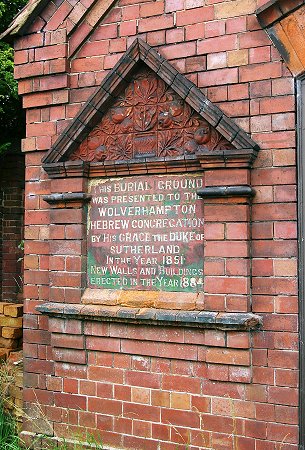
A plaque commemorating the opening of
the burial ground. Courtesy of Martin Rispin. |
The burial ground is not open to the public
but, if you can get the chance to join an occasional guided
tour, it is one of the most remarkable sights in Wolverhampton.
It is hemmed in by housing and factories and one of the busiest
roads in Wolverhampton but within its high walls there seems to
be quiet, order and peace. It is astonishing to come across it,
it has an ark-like quality - like a ship of souls serenely
sailing through troubled waters. Entry is only possible, given
the physical configuration of the site, via a designated key
holder.
We hope to soon have a good account of
Wolverhampton's Jewish Community on this website (there is an
interesting study by William King available in the City
Archives). Suffice it to say here that the Orthodox Jewish
Community has become so small that it no longer runs its own
Synagogue and thus this associated burial ground might be
considered 'at risk' for a variety of reasons. We hope that the
Council will be able to help get funding to restore the Ohel and
make good use off the rest of the site and there are positive
signs that this is now (mid 2010) beginning to be planned for.
|